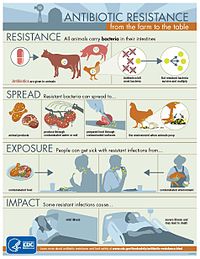
Photo from wikipedia
Colistin was considered as the last-resort drug against severe clinical infections caused by multidrug-resistant Gram-negative pathogens. Mobile colistin resistance (mcr) genes and its variants carried by plasmids have been reported… Click to show full abstract
Colistin was considered as the last-resort drug against severe clinical infections caused by multidrug-resistant Gram-negative pathogens. Mobile colistin resistance (mcr) genes and its variants carried by plasmids have been reported in diverse niches in recent years, and yet few studies reported carriage of mcr-10 in ECC strains of companion animal origin. ABSTRACT Mobile colistin resistance (mcr) genes mediated by plasmids have widely disseminated throughout the world. Recently, 10 mcr genes (mcr-1 to mcr-10) and a large number of variants have been identified in more than 60 countries. However, only a few instances of Enterobacter cloacae complex (ECC) bearing mcr-10 from animal origin have been reported globally. The aim of this study was to fill a knowledge gap in mcr-10-positive ECC of animal origin and analyze the potential transmission trend and different characteristics between human and companion animal isolates. The mcr-10 gene was identified on a self-transmissible plasmid in the human isolate and non-transmissible plasmids in other three animal strains. mcr-10 was adjacent to a XerC-type tyrosine recombinase-gene, and various insertion sequences were located on the downstream of core conservative structure xerC-mcr-10, thus indicating this region might be a candidate for insertions of mobile genetic elements and mcr-10 might be mobilized by IS-mediated mechanisms. Moreover, phylogenetic analysis found that mcr-10-positive isolates were mainly distributed in the clade of Enterobacter roggenkampii, exhibiting significant species specificity. These findings indicated that mcr-10 has emerged among Enterobacter spp. within humans and companion animals, highlighting that the importance of taking effective control measures to monitor the dissemination and evolution of mcr genes. IMPORTANCE Colistin was considered as the last-resort drug against severe clinical infections caused by multidrug-resistant Gram-negative pathogens. Mobile colistin resistance (mcr) genes and its variants carried by plasmids have been reported in diverse niches in recent years, and yet few studies reported carriage of mcr-10 in ECC strains of companion animal origin. How plasmid-borne mcr-10 transmitted in opportunistic pathogens and different characteristics of mcr-10-bearing strains isolated from humans and companion animals are not well understood. In this study, we discovered mcr-10-harboring strains in multidrug-resistant ECC isolates of companion animal origin for the first time and conducted a comprehensive analysis of the genetic environment of mcr-10 from multiple countries around the world, providing the potential basis for formulating control measures to slow down the spread of colistin resistance.
Journal Title: Microbiology Spectrum
Year Published: 2022
Link to full text (if available)
Share on Social Media: Sign Up to like & get
recommendations!